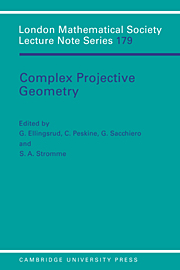Book contents
- Frontmatter
- Contents
- INTRODUCTION
- PROJECTIVE VARIETIES
- VECTOR BUNDLES AND SPECIAL PROJECTIVE EMBEDDINGS
- LIST OF PARTICIPANTS
- Speciality one rational surfaces in P4
- Bounding sections of bundles on curves
- The smooth surfaces of degree 9 in P4
- Compactifying the space of elliptic quartic curves
- Threefolds of degree 11 in P5
- Complete extensions and their map to moduli space
- On the Betti numbers of the moduli space of stable bundles of rank two on a curve
- Gaussian maps for certain families of canonical curves
- Geometry of the Horrocks bundle on P3
- Stability and restrictions of Picard bundles, with an application to the normal bundles of elliptic curves
- Sections planes et majoration du genre des courbes gauches
- A tribute to Corrado Segre
- Un aperçu des travaux mathématiques de G.H. Halphen (1844–1889)
- The source double-point cycle of a finite map of codimension one
- Fibré déterminant et courbes de saut sur les surfaces algébriques
- Courbes minimales dans les classes de biliaison
- Fano 3-folds
- Polarized K3 surfaces of genus 18 and 20
- Protective compactifications of complex afflne varieties
- On generalized Laudal's lemma
- Sur la stabilité des sous-variétés lagrangiennes des variétés symplectiques holomorphes
- Introduction to Gaussian maps on an algebraic curve
- Some examples of obstructed curves in P3
On generalized Laudal's lemma
Published online by Cambridge University Press: 06 July 2010
- Frontmatter
- Contents
- INTRODUCTION
- PROJECTIVE VARIETIES
- VECTOR BUNDLES AND SPECIAL PROJECTIVE EMBEDDINGS
- LIST OF PARTICIPANTS
- Speciality one rational surfaces in P4
- Bounding sections of bundles on curves
- The smooth surfaces of degree 9 in P4
- Compactifying the space of elliptic quartic curves
- Threefolds of degree 11 in P5
- Complete extensions and their map to moduli space
- On the Betti numbers of the moduli space of stable bundles of rank two on a curve
- Gaussian maps for certain families of canonical curves
- Geometry of the Horrocks bundle on P3
- Stability and restrictions of Picard bundles, with an application to the normal bundles of elliptic curves
- Sections planes et majoration du genre des courbes gauches
- A tribute to Corrado Segre
- Un aperçu des travaux mathématiques de G.H. Halphen (1844–1889)
- The source double-point cycle of a finite map of codimension one
- Fibré déterminant et courbes de saut sur les surfaces algébriques
- Courbes minimales dans les classes de biliaison
- Fano 3-folds
- Polarized K3 surfaces of genus 18 and 20
- Protective compactifications of complex afflne varieties
- On generalized Laudal's lemma
- Sur la stabilité des sous-variétés lagrangiennes des variétés symplectiques holomorphes
- Introduction to Gaussian maps on an algebraic curve
- Some examples of obstructed curves in P3
Summary
Introduction. Let C be an integral curve in P3 of degree d and let Γ = C∩H be the generic plane section. The idea of using Γ in order to deduce properties of C goes back to Castelnuovo and has been successfully used by many authors especially in the following problem: determine the maximum genus G(d, s) of a smooth curve of degree d not lying on a surface of degree <s (see [HH], [E] for more informations). For this reason this method is called Castelnuovo method.
In this paper we discuss the following problem: given the Hilbert function of Γ, deduce some information about the least degree of a surface containing C.
Section 1 is devoted to recall some known results in this direction; the main result is Laudal's lemma which says that, if C is integral of degree d > σ2+1 and Γ is contained in a curve of H of degree σ, then C is contained in a surface of degree σ (see [L], Corollary p. 147 and [GP], Lemme).
On the other hand very little is known about curves of degree d, such that Γ is contained in a curve of H of degree σ and C is not contained in a surface of degree σ. In the remaining sections we give some partial results in the previous situation. In particular the following two theorems are proved for an integral curve C.
a) If Γ is contained in a curve of H of degree σ and d > σ2-σ+4, then C lies on a surface of degree σ+1.
[…]
- Type
- Chapter
- Information
- Complex Projective GeometrySelected Papers, pp. 284 - 293Publisher: Cambridge University PressPrint publication year: 1992
- 8
- Cited by

